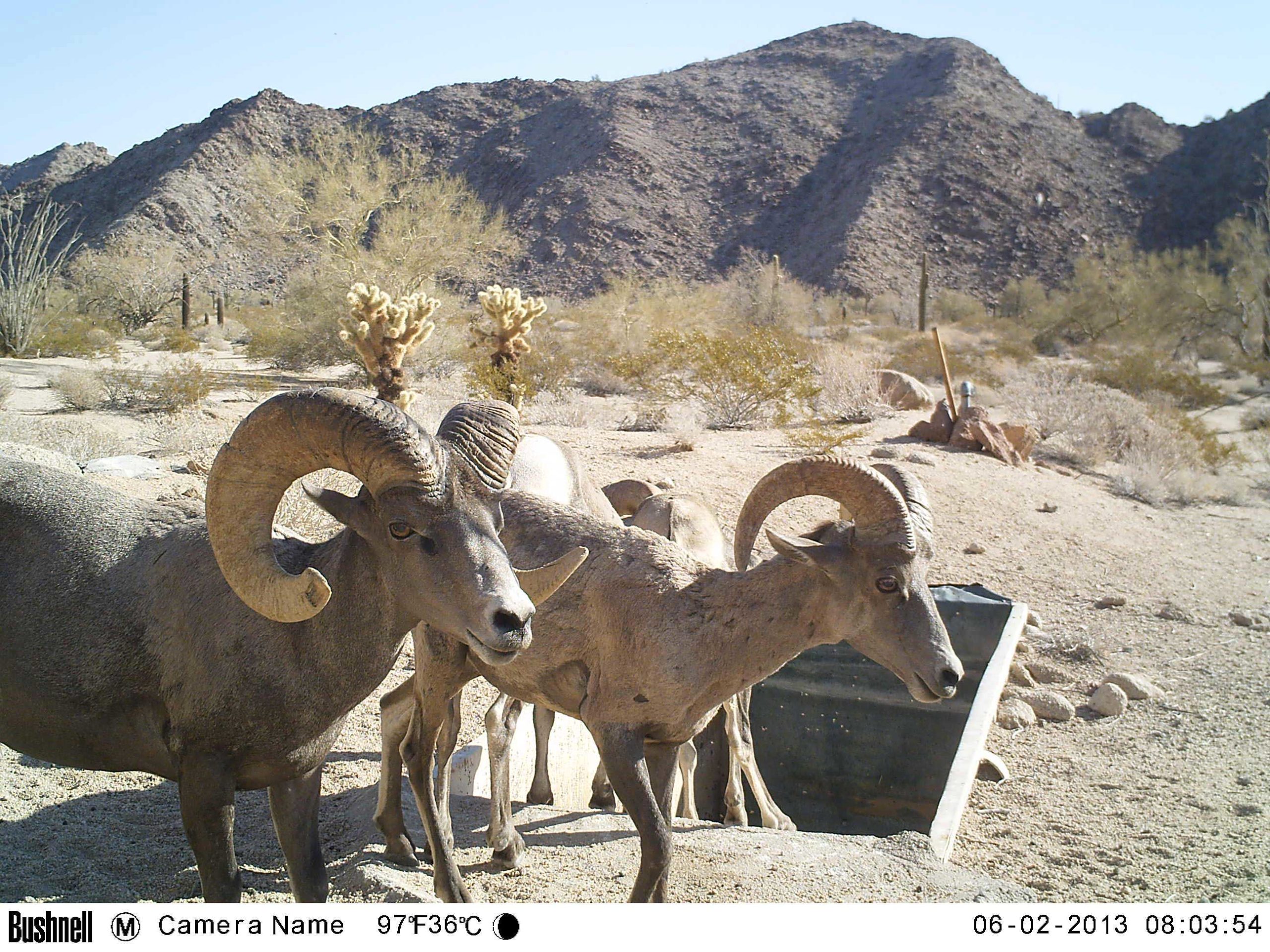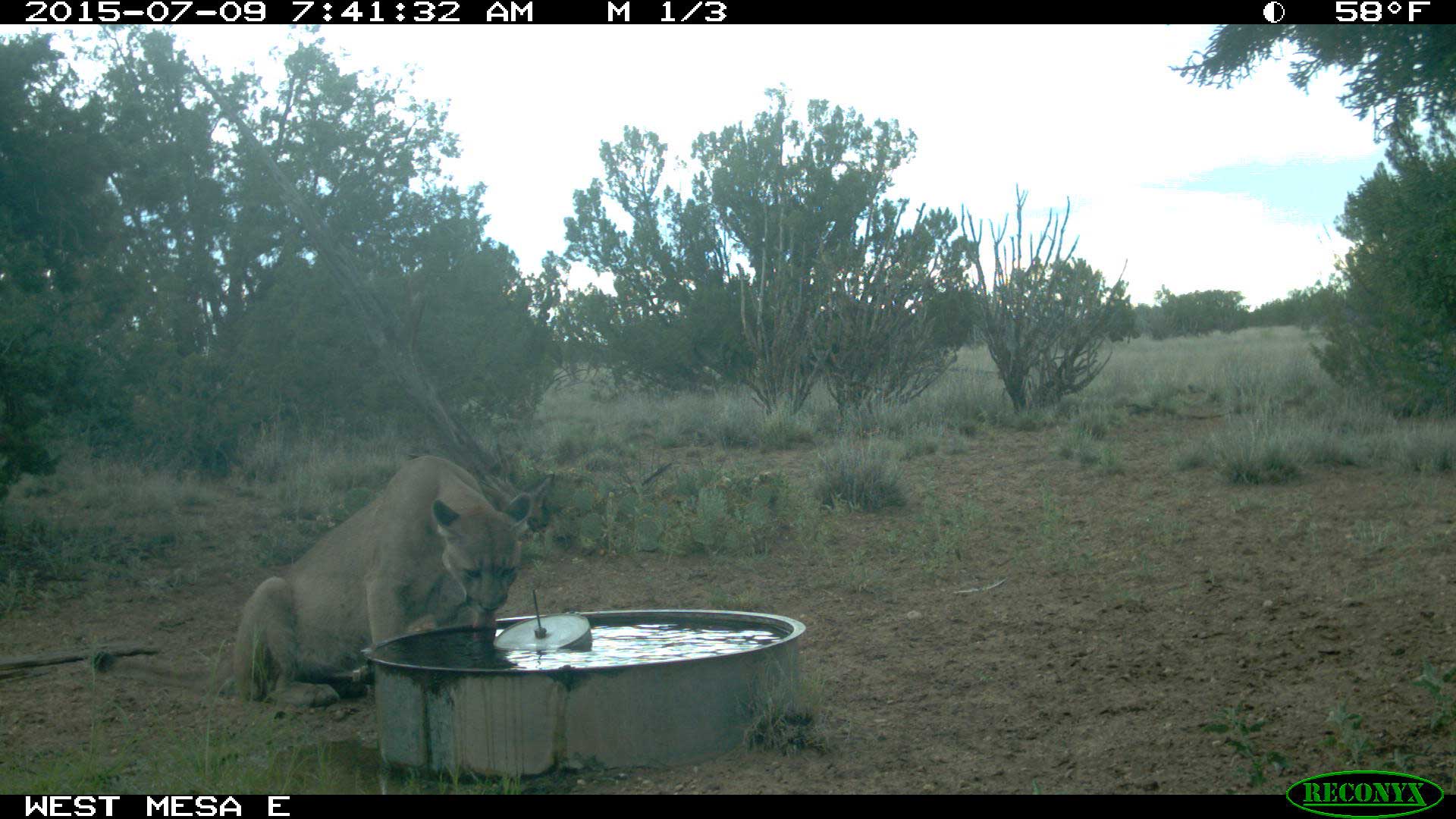Wildlife managers have long used water, especially in the arid Southwest, as a tool to help support healthy animal populations. What began as a handful of managed water sites for quail and mule deer around 1940 blossomed into some 6,000 sites, intended to increase populations and benefit overall health for dozens of mostly game species in 10 western states by the close of the 20th century. Provisional water – contained in troughs, large tires, basins, open tanks and dammed-up pools ¬¬– is now used to support a vast range of wildlife management and species conservation work, from increasing mule deer and other game populations to recovery efforts for endangered Sonoran pronghorn and desert bighorn sheep.
 A new study, however, reveals that in some cases, use of the common wildlife management tool can be fine-tuned to optimize benefits for targeted species by reducing risk from predators that are likewise drawn to the same water sources. Published in PLOS One, the Public Library of Science’s peer-reviewed open-access scientific journal, the research represents significant implications for other like-minded wildlife management efforts.
A new study, however, reveals that in some cases, use of the common wildlife management tool can be fine-tuned to optimize benefits for targeted species by reducing risk from predators that are likewise drawn to the same water sources. Published in PLOS One, the Public Library of Science’s peer-reviewed open-access scientific journal, the research represents significant implications for other like-minded wildlife management efforts.
Conducted by biologists from the U.S. Fish and Wildlife Service, the Department of Defense and others, the study examined when endangered desert bighorn sheep, as well as deer, puma and coyotes, visit managed water sources (drinkers) in three distinct Southwestern desert ecosystems.
“Desert bighorn sheep visit water when it’s hot and dry,” says Fish and Wildlife Service biologist Grant Harris. “Mountain lions visit water year-round. Take home: Provide water only when bighorn sheep are likely to visit, which could reduce mountain lion range expansion and predation on sheep.”
***
For six and a half years, from July 2009 through December 2016, Harris and fellow researchers analyzed imagery from remote cameras set up at 105 drinkers throughout the Chihuahuan, Sonoran and Mojave deserts. By calculating the mean proportion of visits to water catchments per month for each site, the team was able to hone in on exactly when desert bighorn sheep, mule deer, coyotes and mountain lions visited the sites.
The research revealed that in the Chihuahuan Desert, 70% of all desert bighorn sheep visits occurred from April through August. In the Sonoran, 85% of sheep visits occurred from May through August, and in the Mojave, 83% of sheep visits occurred from May through September. While sheep favored these four- to five-month brackets during hotter seasons to visit water sites, the site surveys revealed different visitation patterns for coyotes and mountain lions, which visited the drinkers throughout the entire year.
“It’s pretty simple,” says David Brown, a wildlife biologist with Arizona State University and co-author of the recent study. “Everyone with a hunting dog knows that canids and larger carnivores require more water than desert-adapted ungulates. The (study) merely documents this fact for all to see — a fact often overlooked by ungulate water purveyors.”
Indeed, numerous wildlife studies suggest that the benefits of wildlife management protocols that include provisional water may at times be negligible, or that the practice is potentially counterproductive. Yet, despite concerns that water provisioning may favor more water-dependent species, increase predation and reduce biodiversity, wildlife agencies continue to provide water year-round throughout many arid lands of Africa, Australia and the United States, ostensibly to increase game populations and enhance biodiversity.

“We know from studies outside of the U.S. that water holes attract predators, so it was unsurprising that mountain lions frequented waters year-round,” says David R. Stewart, a Fish and Wildlife Service biologist and another co-author of the new study. “In fact, and talking with hunters in New Mexico and Arizona, they, too, seek out water as they pursue their table fare for species like deer and elk. Regardless, drinkers provide a benefit and are a management tool that biologists might be able to use to help sustain populations. However, and like any management tool, biologists and managers need to consider when to use it and when not to use it for the betterment of the species they are managing.”
Stewart suggests that the research team’s findings represent a first step in determining how best to use supplemental water sources in the wildlife management arena. The next is determining with more precision the efficacy of these management tools. For example: What happens to sheep and mountain lion numbers if water is provided for only a few months of the year? Do predators leave the area? Do sheep numbers decline? Do they remain stable because they’re using high mountain springs or other unknown natural water sites?
“Movement ecology will play a critical role in helping us answer these questions,” says Stewart. “By taking a closer look at this situation, then we can refine how we manage sheep using water provisions.”
For now, the study adds to an important and growing body of science that points to a clear conclusion: Improving water management hinges on understanding wildlife visitation patterns and tailoring management towards the species justifying provisional water.
 New Mexico Wildlife magazine Conserving New Mexico's Wildlife for Future Generations
New Mexico Wildlife magazine Conserving New Mexico's Wildlife for Future Generations
